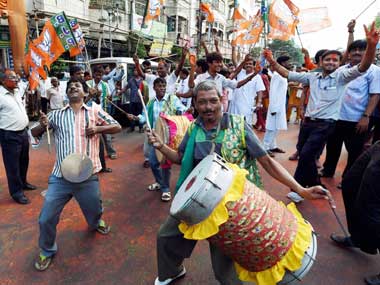By Mathew V New Delhi: Will 6 Muralidhar Sen Lane, the state headquarters of the BJP, be the new Alimuddin Street, the headquarters of the CPM? These are early days, and the CPM is no spent force yet, but the question has started dominating political discussions with the saffron party expanding its footprint on the electoral space in West Bengal. While the bye-elections may not confirm a trend of the BJP becoming the principal opposition force by displacing the CPM-led Left Front, they do give pointers. If the party is able to find dynamic state-level leaders and good communicators they could be on course to reach that position. Yes, it needs to sustain its political campaign, which has largely been Kolkata-centric, and build a statewide organizational base too. [caption id=“attachment_1724971” align=“alignleft” width=“380”]
 BJP activists dance in-front of their party office to celebrate their victory in Basirhat Dakshin Constituency in State Assembly by-election in Kolkata on Tuesday.
PTI[/caption] The enthusiasm among the limited cadre is visible already. On 16 September, as results of the Chowringhee and Basirhat South assembly segments were pouring in, there was a mood of celebration among the party workers. They smeared each other with saffron abir (dye used during Holi, the festival of colours) as the news of Samik Bhattacharya winning the Basirhat Dakshin was announced. The BJP had stormed the West Bengal assembly seat for the first time on its own in these elections. It had last won a seat in the state way back in 1999 in alliance with the Trinamool Congress. Badal Bhattacharya, the debutant BJP MLA in the Bengal assembly – he won the Ashokenagar seat in 24 Parganas, is no longer in active politics and leads a retired life. What should be particularly encouraging for the BJP is that the Basirhat Dakshin seat has a 35 percent minority population. Although the minority vote shifted almost wholesale from the Left and the Congress to the TMC, the BJP still managed to win the seat, albeit by a slender margin of 1,586 votes. The bye-elections were fought on local issues and the BJP could no longer bank on the ‘Modi wave’. So the results are definitely creditable to the state unit of the BJP. Once proud of a well-oiled party machinery which could never lose an election, the CPM is a shadow of its former self now. In both the Chowringhee and the Basirhat Dakshin seat its candidates forfeit their deposits. A large number of its cadres have switched allegiance to the BJP overnight and while the incumbent TMC government has given plenty of opportunities for the Left to reconnect with the masses, they seem to have failed in it. Organisational deficiencies apart, the leadership is ageing, which only accentuates the social disconnect. In Chowringhee, the CPM won a mere 9.19 percent vote share, down from the 19.64 per cent the Left-backed Rashtriya Janata Dal had got in the 2011 Assembly elections, thereby losing the deposit (one needs to win 1/6th of the total valid votes polled to avoid forfeiting the deposit). In Basirhat South also, the CPM got just 13.03 per cent and thereby forfeited their deposit. Alarm bells must be ringing in the Alimuddin Street headquarters of the party as they have been winning this seat consistently since 1977. Even in the 2011 assembly polls, the CPM had won here although they had lost the assembly elections in the state to the TMC-Congress combine. With equations on the ground changing, the upcoming assembly elections in 2016 promises to be a cracker of a fight with a beleaguered and vulnerable TMC, a depleted Left, a confused Congress and a resurgent BJP in the race.
While the bye-elections may not confirm a trend of the BJP becoming the principal opposition force by displacing the CPM-led Left Front, they do give pointers.
Advertisement
End of Article
Written by FP Archives
see more


)
)
)
)
)
)
)
)
)



